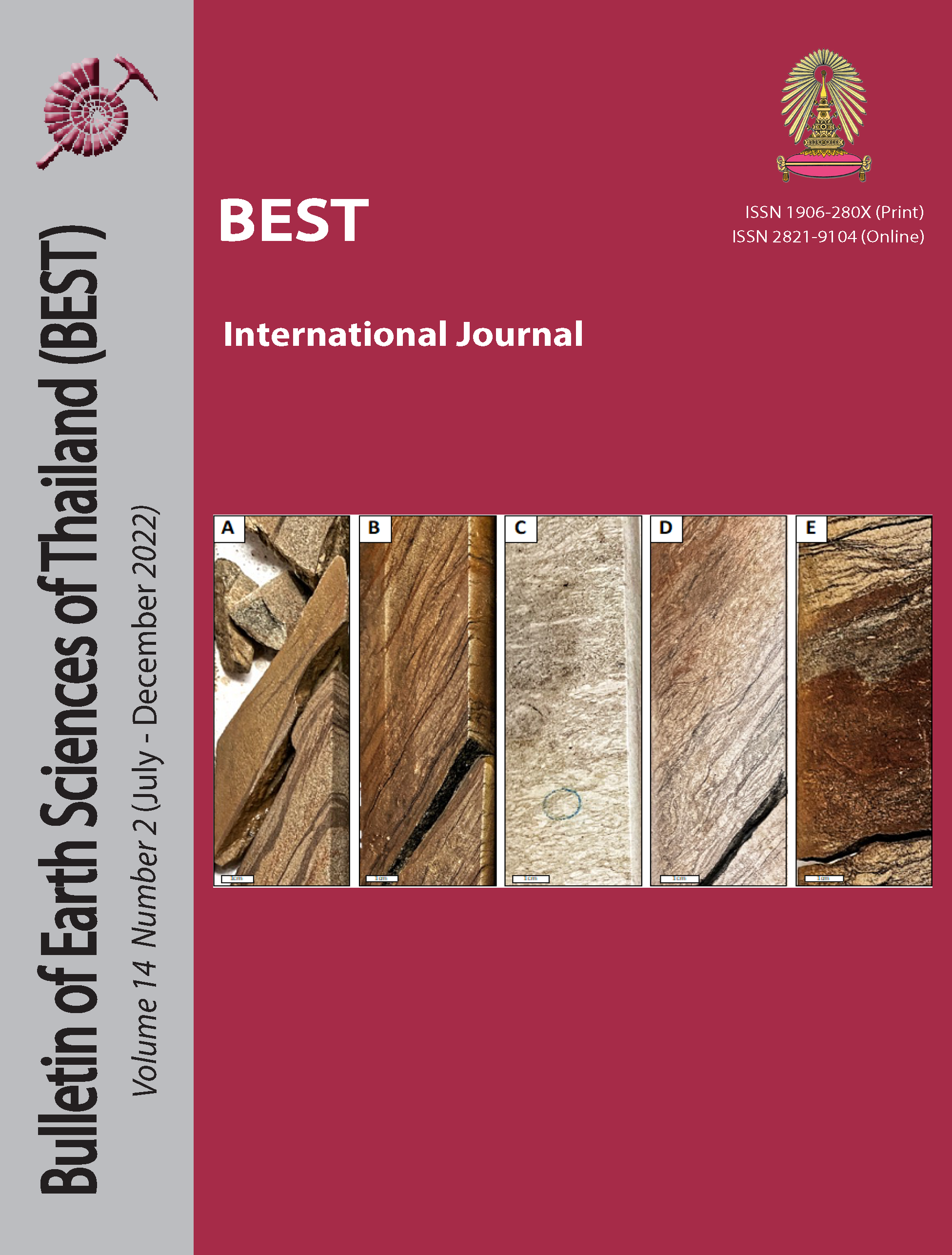Facies analysis and reservoir characteristics of 2E unit in North Malay Basin, Gulf of Thailand
Main Article Content
Abstract
The study is conducted to better understand the stratigraphy and depositional environment of 2E unit in Block A of the North Malay Basin. This research integrated core interpretations and well data to establish the lithofacies and reservoir characteristics of the 2E unit by utilizing four cored wells.
Depositional environments resulted from lithofacies associations, suggesting that the 2E unit was deposited in a tide-dominated delta where was influenced by the alternation of fluvial and tidal processes. Sandstone-dominated facies (Ss, Sx, Sr, Sm, Sc, and Sf) were commonly deposited within the mouth of the river, including fluvial channels, tidally dominated channels, and tidal bars. In contrast, the mudstone-dominated facies (Ml and Mp) and bioturbated heterolithic facies (Sb) were indicated to lower energy conditions such as tidal flats deposits.
Three flow units are categorized by using a porosity-permeability cross plot, ranked in order of decreasing average porosities and permeabilities: (1) Stratified sandstone group, (2) Heterogeneous sandstone group, and (3) Mudstone group. Reservoir qualities are good to excellent in the stratified sandstone group, with average porosity of 27% and several hundreds of mD to 3.8 D of permeability. On the other hand, lower quality reservoirs are observed in the heterogeneous sandstone group, which has significantly low permeability, less than 100 mD.
Article Details

This work is licensed under a Creative Commons Attribution-NonCommercial-NoDerivatives 4.0 International License.
Copyright © 2008 Department of Geology, Faculty of Science, Chulalongkorn University. Parts of an article can be photocopied or reproduced without prior written permission from the author(s), but due acknowledgments should be stated or cited accordingly.
References
Boggs, S.Jr. (2013). Principle of sedimentology and stratigraphy (5th edition). Pearson Education Limited.
Crumeyrolle P. (1995). Sedimentological review of the Bongkot area cored section. TOTAL (Internal report).
Crumeyrolle P. (1996). Sedimentological review of the Bongkot area cored section Part 2. TOTAL (Internal report).
Drunesne D., and Crumeyrolle P. (1993). Stratigraphy and reservoir geometry of the Bongkot field: An integrated study using 3D seismic and well-log data. TOTAL (Internal report).
Lefeuvre F. (1995). Reservoir characterization from seismic attributes on the Bongkot field. TOTAL (Internal report).
Li, S., Shengli, L., Shan, X., Gong, C., and Yu, X. (2017). Classification, formation, and transport mechanisms of mud clasts. International Geology Review, 59(12), 1609-1620.
Morley, C.K., Charusiri, P., and Watkinson, I. (2011). Structural geology during the Cenozoic. In: Ridd, M.F., Barber, A.J., Crow, M.J. (Eds.), The Geology of Thailand. The Geological Society, London, 273–334.
Morley, C. K. and Racey, A. (2011). Tertiary stratigraphy. In: Ridd, M.F., Barber, A.J., Crow, M.J. (Eds.), The Geology of Thailand. The Geological Society, London, 223–271.
Nichols, G. (1999). Sedimentology and Stratigraphy (2nd edition), John Wiley&Son Ltd., West Sussex, UK., 419p.
Reineck, H.E. and Wunderlich, F. (1968). Classification and origin of flaser and lenticular bedding. Sedimentology, 11, 99–104.
Shoup R. (2008). Palaeogeographic reconstruction of the Arthit Area, North Malay Basin. Proceedings of International Symposia on Geoscience Resources and Environments of Asian Terranes. Chulalongkorn University, Bangkok, Thailand, November 24–26, 375–381.
Taylor A.M. and Goldring R. (1993). Description and analysis of bioturbation and ichnofabric. Journal of the Geological Society, 150(1), 141–148.


